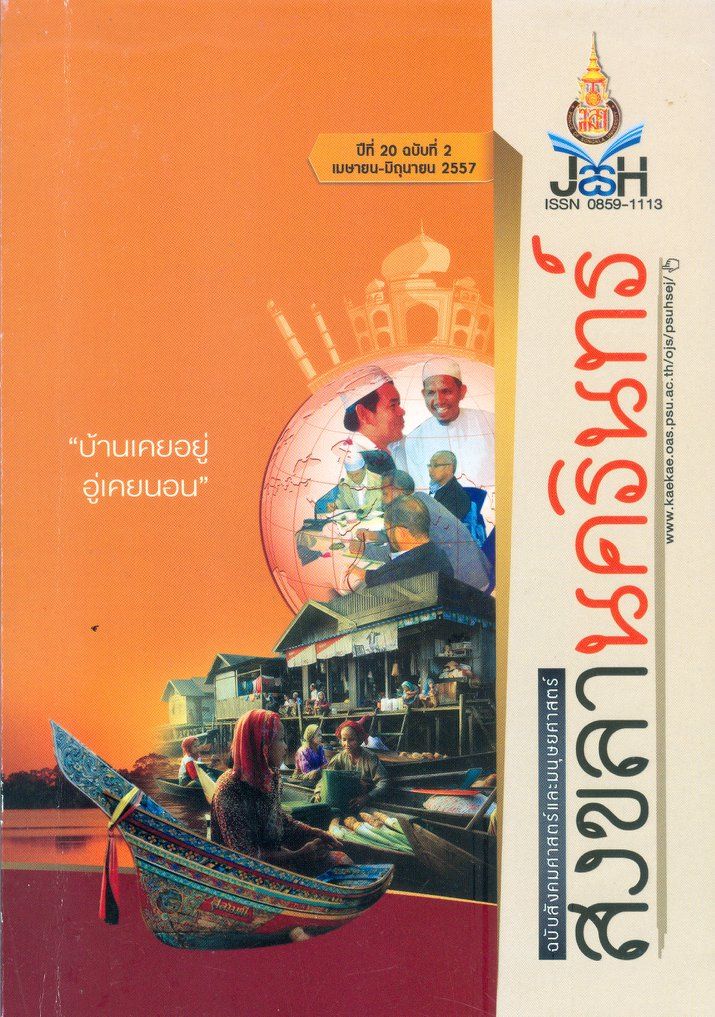<b>การปรับตัวของวิถีชีวิตพื้นถิ่นที่ปรากฏในเรือนของชุมชนไทยพุทธลุ่มทะเลสาบสงขลา </b><br> Adaptability of Local Living in Vernacular Houses: Buddhist Thai Communities of Songkhla Lake Basin
Abstract
Abstract
This article based on the research that has explored the relationships between community ecosystems and ways of life in the context of modern development, especially searching how these relationships are manifested in the changing physical characteristics of their vernacular houses. Methodologically, using qualitative methods including a holistic approach to the study of tradition and change, three Buddhist Thai communities of Songkhla Lake Basin were selected for comparative study: Thale Noi community in Phatthalung Province, Krasae Sin and Chingco communities in Songkhla Province. Five traditional Southern Thai Houses of each community were selected as the characteristics of their vernacular houses of Songkhla Lake Basin in Southern Thai context display micro-scale differences which are significantly determined by the differences in community ecosystems which were effected by governmental modern developments. The traditional communities and their dwellings were transformed to be a new characteristic of Southern Thai communities related with way of life underlie the emergence of hybrid economic and socio-culture. So, the vernacular architecture is not only a portrait as art and culture but it is living culture. However, kinship ties, their Buddhist beliefs and experience of adaptability reinforce the existent of local identities.
บทคัดย่อ
บทความนี้เป็นส่วนหนึ่งของงานวิจัยที่มุ่งค้นหา ความสัมพันธ์ระหว่างระบบนิเวศชุมชนกับวิถีชีวิต ชาวบ้านท่ามกลางกระแสการพัฒนาสมัยใหม่ที่ก่อ ให้เกิดความเปลี่ยนแปลงต่อลักษณะกายภาพของ เรือนพื้นถิ่น โดยใช้การศึกษาวิจัยเชิงคุณภาพและใช้ กรอบมุมมองแบบองค์รวมในการศึกษาความ เปลี่ยนแปลงและใช้การศึกษาเปรียบเทียบโดยเลือก ชุมชนไทยพุทธลุ่มทะเลสาบสงขลาจำนวน 3 ชุมชน ไดแ้ ก ่ ชุมชนทะเลนอ้ ย จังหวัดพัทลุง ชุมชนกระแสสินธุ์ และชุมชนชิงโค จังหวัดสงขลา และคัดเลือกเรือน เพื่อใช้ศึกษา ชุมชนละ 5 หลัง ผลการวิจัยนี้พบว่า ลักษณะทางกายภาพของเรือนพื้นถิ่นในชุมชนไทย พุทธลุ่มทะเลสาบสงขลาภายใต้บริบทของสภาพ แวดล้อมและวัฒนธรรมภาคใต้มีความแตกต่างกัน ในระดับระบบนิเวศชุมชนและผลกระทบจากการพัฒนา สมัยใหม่ของภาครัฐ ชาวบ้านได้ปรับวิถีชีวิตในระดับ เศรษฐกิจชุมชนและสังคมวัฒนธรรมคู่ขนานไปกับ ความทันสมัยในบริบทปัจจุบัน ทำให้ลักษณะทาง กายภาพของเรือนกลายรูปแตกต่างกัน เกิดเรือน พื้นถิ่นแบบใหม่ที่ผันแปรตามความเปลี่ยนแปลงของ วิถีชีวิตในเรือน โดยไม่ได้เป็นเพียงภาพนิ่งในฐานะ ตัวแทนของศิลปวัฒนธรรม แต่สะท้อนความเข้มข้น ของความเป็นชีวิตวัฒนธรรม อย่างไรก็ตาม ปัจจัย ที่ทำให้ชุมชนไทยพุทธลุ่มทะเลสาบสงขลายังคงไม่ เปลี่ยนแปลงอย่างสิ้นเชิงในบริบทใหม่ คือ ระบบความ สัมพันธ์เครือญาติที่ยังร้อยรัด และความคิดความเชื่อ ทั้งเนื่องมาจากพุทธศาสนาและจากประสบการณ์ การปรับตัวต่อเนื่องมาจากอดีตของชาวใต้











